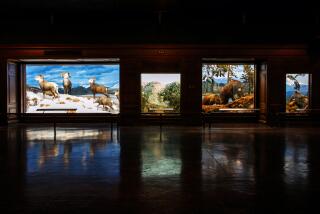Drawing from scientific accuracy
- Share via
STOCKBRIDGE, Mass. — It’s a ferocious-looking creature with razor-sharp teeth, leathery skin and enormous three-toed feet propelling it across a prehistoric landscape toward a herd of smaller beasts running away in terror.
It’s the giganotosaurus, a 42-foot dinosaur found fossilized in Patagonia and animated in the pages of National Geographic in 1997.
“My job was to do a picture of him coming toward us,” said James Gurney, the painter who brought the towering carnivore to life for the magazine’s readers. All he had on which to base the image was the creature’s bones and research done by the scientist who found them.
“It’s like wildlife art for time travelers,” Gurney said from his studio in Rhinebeck, N.Y.
The collaboration between artists and scientists has created some of National Geographic’s most vivid images, allowing the magazine to illustrate what photographs cannot.
Gurney’s giganotosaurus and dozens of other paintings that show historical events, cross-sections of insects and futuristic space travel fuse scientific discovery with fine art in “National Geographic: The Art of Exploration,” an exhibit on display at the Norman Rockwell Museum until May 31.
“It takes a special breed of artist to be an illustrator for National Geographic,” said Stephanie Plunkett, the Rockwell museum’s curator of illustrated art. “There’s lots of collaboration between the researchers and the artists, and it could take over a year to get it right.”
In “Surrender at Appomattox,” Tom Lovell was faced with having to make a picture based on historical accounts of Robert E. Lee surrendering his Confederate army to Ulysses S. Grant. The generals met on April 9, 1865, but there was no photograph taken of the event that ended the Civil War.
When he painted the scene 100 years later, Lovell studied other photographs taken of Grant and Lee from that time and found out how their uniforms would have been designed.
He relied on eyewitness accounts and descriptions of how the meeting room was furnished. The color of the carpet, the design of the desks and the location of the fireplace were the result of research, not artistic license.
“It’s got to be accurate,” said Howard Paine, the exhibition curator and former National Geographic art director who worked at the magazine from 1957 to 1990. “That’s the flag we fly under. The illustrations aren’t decorative or something for a kid’s book.”
National Geographic began publishing a century ago as a scholarly paper. When editors began using pictures to illustrate some articles, they took note of how popular the decision was and capitalized on the idea.
The magazine is renowned for its photographs but would often be at a loss if not for illustrations.
A 1996 article about a South American bird-eating spider featured an illustration by Christopher Klein that showed a cutaway view of the arachnid’s anatomy. Its organs are color-coded and vividly displayed in the context of the spider’s body.
“If you were to do a dissection and photograph it, it would basically look like pudding,” Plunkett said.
Though the artwork illustrates the past and the hard-to-see, it’s also used to project the future.
To depict a manned mission to Mars, Pierre Mion interviewed NASA officials to get an idea of what the spacecraft would look like, how large the oxygen and fuel tanks should be and how the engines would be designed.
He painted “Escape From Earth’s Orbit” in 1988, showing a spacecraft that could house eight astronauts and sustain them for a would-be trip to Mars.
“That won’t happen in my lifetime,” said Mion, who is 74. “But that art is based on serious consideration and reasonable facts. You just don’t make stuff up for National Geographic.”
More to Read
Sign up for The Wild
We’ll help you find the best places to hike, bike and run, as well as the perfect silent spots for meditation and yoga.
You may occasionally receive promotional content from the Los Angeles Times.






